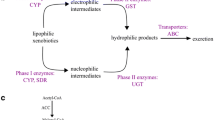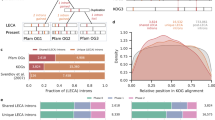Abstract
Spliced leader trans-splicing is an mRNA maturation process used by a small set of eukaryotes, including the nematode C. elegans, to cap the downstream genes of operons. We analyzed the frequency of duplication of operonic genes in C. elegans and confirmed that they are duplicated less often in the genome than monocistronic genes. Because operons account for about 15% of the genes in C. elegans, this lower duplication frequency might place a large constraint on the plasticity of the genome. Further analyses suggest that this paucity of duplicated genes results from operon organization hindering specific types of gene duplication.
Similar content being viewed by others
References
Agabian N (1990) Trans splicing of nuclear pre-mRNAs. Cell 61:1157–1160
Bi X, Liu LF (1996) DNA rearrangement mediated by inverted repeats. Proc Natl Acad Sci USA 93:819–823
Blumenthal T (1995) Trans-splicing and polycistronic transcription in Caenorhabditis elegans. Trends Genet 11:132–136
Blumenthal T, Gleason KS (2003) Caenorhabditis elegans operons: form and function. Nat Rev Genet 4:112–120
Blumenthal T, Evans D, Link CD, Guffanti A, Lawson D, Thierry-Mieg J, Thierry-Mieg D, Chiu WL, Duke K, Kiraly M, Kim SK (2002) A global analysis of Caenorhabditis elegans operons. Nature 417:851–854
Cavalcanti AR, Ferreira R, Gu Z, Li WH (2003) Patterns of gene duplication in Saccharomyces cerevisiae and Caenorhabditis elegans. J Mol Evol 56:28–37
Cohen A, Hassin D, Karby S, Lavi S (1994) Hairpin structures are the primary amplification products:a novel mechanism for generation of inverted repeats during gene amplification. Mol Cell Biol 14:7782–7791
Davis RE (1996) Spliced leader RNA trans-splicing in metazoa. Parasitol Today 12:33–40
Ebel C, Frantz C, Paulus F, Imbault P (1999) Trans-splicing and cis-splicing in the colourless Euglenoid, Entosiphon sulcatum. Curr Genet 35:542–550
Evans D, Zorio D, MacMorris M, Winter CE, Lea K, Blumenthal T (1997) Operons and SL2 trans-splicing exist in nematodes outside the genus Caenorhabditis. Proc Natl Acad Sci USA 94:9751–9756
Frantz C, Ebel C, Paulus F, Imbault P (2000) Characterization of trans-splicing in euglenoids. Curr Genet 37:349–355
Ganot P, Kallesoe T, Reinhardt R, Chourrout D, Thompson EM (2004) Spliced-leader RNA trans splicing in a chordate, Oikopleura dioica, with a compact genome. Mol Cell Biol 24:7795–7805
Gordon AJ, Halliday JA (1995) Inversions with deletions and duplications. Genetics 140:411–414
Graur D, Li WH (2000) Fundamentals of molecular evolution. Sinauer Associates, Sunderland, MA
Gu Z, Cavalcanti A, Chen FC, Bouman P, Li WH (2002) Extent of gene duplication in the genomes of Drosophila, nematode, and yeast. Mol Biol Evol 19:256–262
Harris TW, Chen N, Cunningham F, et al. (2004) WormBase: a multi-species resource for nematode biology and genomics. Nucleic Acids Res 32:D411–D417
Huang T, Kuersten S, Deshpande AM, Spieth J, MacMorris M, Blumenthal T (2001) Intercistronic region required for polycistronic pre-mRNA processing in Caenorhabditis elegans. Mol Cell Biol 21:1111–1120
Lawrence J (1999) Selfish operons: the evolutionary impact of gene clustering in prokaryotes and eukaryotes. Curr Opin Genet Dev 9:642–648
Lercher MJ, Blumenthal T, Hurst LD (2003) Coexpression of neighboring genes in Caenorhabditis elegans is mostly due to operons and duplicate genes. Genome Res 13:238–243
Lin CT, Lin WH, Lyu YL, Whang-Peng J (2001) Inverted repeats as genetic elements for promoting DNA inverted duplication:implications in gene amplification. Nucleic Acids Res 29:3529–3538
Lynch M, Conery JS (2000) The evolutionary fate and consequences of duplicate genes. Science 290:1151–1155
Katju V, Lynch M (2003) The structure and early evolution of recently arisen gene duplicates in the Caenorhabditis elegans genome. Genetics 165:1793–1803
Maere S, De Bodt S, Raes J, Casneuf T, Van Montagu M, Kuiper M, Van de Peer Y (2005) Modeling gene and genome duplications in eukaryotes. Proc Natl Acad Sci USA 102:5454–5459
Nilsen TW (1993) Trans-splicing of nematode premessenger RNA. Annu Rev Microbiol 47:413–440
Papp B, Pal C, Hurst LD (2003) Dosage sensitivity and the evolution of gene families in yeast. Nature 424:194–197
Pearson WR, Lipman DJ (1988) Improved tools for biological sequence comparison. Proc Natl Acad Sci USA 85:2444–2448
Rost B (1999) Twilight zone for protein sequences alignments. Protein Eng 12:85–94
Stover NA, Steele RE (2001) Trans-spliced leader addition to mRNAs in a cnidarian. Proc Natl Acad Sci USA 98:5693–5698
Thompson JD, Higgins DG, Gibson TJ (1994) CLUSTAL W: improving the sensitivity of progressive multiple sequence alignment through sequence weighting, positions-specific gap penalties and weight matrix choice. Nucleic Acids Res 22:4673–4680
Vandenberghe AE, Meedel TH, Hastings KE (2001) mRNA 5′-leader trans-splicing in the chordates. Genes Dev 15:294–303
Veitia RA (2004) Gene dosage balance in cellular pathways: implications for dominance and gene duplicability. Genetics 168:569–574
Woollard A (2005) Gene duplications and genetic redundancy in C. elegans. In: The C. elegans Research Community (ed) WormBook. doi/10.1895/wormbook.1.2.1. Available at: http://www.wormbook.org
Yang Z (1997) PAML:a program package for phylogenetic analysis by maximum likelihood. CABIOS 13:555–556
Zorio DA, Cheng NN, Blumenthal T, Spieth J (1994) Operons as a common form of chromosomal organization in C elegans. Nature 372:270–272
Acknowledgment
This work was supported by NIGMS Grant GM59708 to L.F.L.
Author information
Authors and Affiliations
Corresponding author
Additional information
[Reviewing Editor: Dr. Yves van de Peer]
Rights and permissions
About this article
Cite this article
Cavalcanti, A.R., Stover, N.A. & Landweber, L.F. On the Paucity of Duplicated Genes in Caenorhabditis elegans Operons. J Mol Evol 62, 765–771 (2006). https://doi.org/10.1007/s00239-005-0203-3
Received:
Accepted:
Published:
Issue Date:
DOI: https://doi.org/10.1007/s00239-005-0203-3




